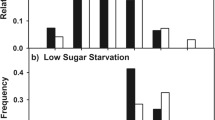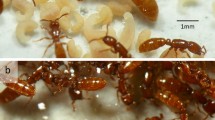Abstract
Stomodeal trophallaxis plays a major role in ant colony nutrition and communication. While the rate of food distribution at the individual level (worker to worker) is rapid, factors affecting the rate of food distribution at the colony level remain poorly understood. We used the odorous house ant, Tapinoma sessile (Say), as a model species to investigate the factors affecting the rate of spread of liquid carbohydrate food throughout a colony. To track the movement of the food we used protein marking and double antibody sandwich enzyme-linked immunosorbent assay, DAS-ELISA. Increasing colony size while keeping the number of donor workers constant significantly decreased the number of individuals testing positive for the marker. After 8 h of trophallactic interactions with ten donors, 92 ± 5% of recipient workers tested positive in a colony of 125 and 38 ± 5% tested positive in a colony of 1,000. Interestingly, as colony size increased and the percentage of workers testing positive decreased, the proportion of workers actually receiving food increased. Food originating from a single donor fed approximately 12 individuals in colonies comprised of 125 recipients and approximately 38 individuals in colonies comprised of 1,000 recipients. Thus, the per capita consumption of food decreased as colony size increased, most likely because the amount of food reaching the colony was limited. Increasing the number of donors while keeping colony size constant significantly increased the number of recipient ants testing positive for the marker. As the number of donor workers doubled, the percentage of recipients testing positive more than doubled suggesting that the number of individuals receiving food increases with increasing colony size, while the per capita amount of food decreases. When food was available ad libitum and in close proximity to the nest, numerous workers fed directly at the food source. This dramatically increased the rate and the extent of food distribution to both the workers and the queens and colony size had no significant effect on the spread of the marker in the workers or the queens. The rate and the extent of food distribution at the colony level may depend on a number of factors including the number of successful foragers, the size and density of the recipient colony, and the recipient caste.

Similar content being viewed by others
References
Bhatkar A.D. and Whitcomb W.H. 1970. Artificial diet for rearing various species of ants. Florida Entomol. 53: 229–232
Boulay R., Hefetz A., Soroker V. and Lenoir A. 2000. Camponotus fellah colony integration: worker individuality necessitates frequent hydrocarbon exchanges. Anim. Behav. 59: 1127–1133
Buczkowski G. and Bennett G.W. 2006. Dispersed central-place foraging in the polydomous odorous house ant, Tapinoma sessile as revealed by a protein marker. Insect. Soc. 53: 282–290
Buczkowski G. and Bennett G.W. 2007. Protein marking reveals predation on termites by the woodland ant, Aphaenogaster rudis. Insect. Soc. 54: 219–224
Buczkowski G. and Bennett G.W. 2008. Seasonal polydomy in a polygynous supercolony of the odorous house ant, Tapinoma sessile. Ecol. Entomol. 33: 780–788
Choe J.C. and Crespi D.J. (Eds) 1997. The Evolution of Social Behavior in Insects and Arachnids. Cambridge University Press, Cambridge, UK. 541 pp
Dahbi A., Hefetz A., Cerda X. and Lenoir A. 1999. Trophallaxis mediates uniformity of colony odor in Cataglyphis iberica ants (Hymenoptera, Formicidae). J. Insect Behav. 12: 559–567
Davidson D.W. 1997. Foraging ecology and community organization in desert seed-eating ants. Ecology 58: 725–737
Dussutour A., Beshers S., Deneubourg J.-L. and Fourcassié V. 2007. Crowding increases foraging efficiency in the leaf-cutting ant Atta colombica. Insect. Soc. 54: 158–165
Farina W.M. 1996. Food exchange by foragers in the hive- a means of communication among honey bees? Behav. Ecol. Sociobiol. 38: 59–64
Farina W.M., Grüter C., Acosta L. and Mc Cabe S. 2007. Honeybees learn floral odors while receiving nectar from foragers within the hive. Naturwissenschaften 94: 55–60
Gordon D.M. and Mehdiabadi N.J. 1999. Encounter rate and task allocation in harvester ants. Behav. Ecol. Sociobiol. 45: 370–377
Howard D.F. and Tschinkel W.R. 1980. The effect of colony size and starvation on food flow in the fire ant, Solenopsis invicta (Hymenoptera: Formicidae). Behav. Ecol. Sociobiol. 7: 293–300
Howard D.F. and Tschinkel W.R. 1981. The flow of food in colonies of the fire ant, Solenopsis invicta: a multifactorial study. Physiol. Entomol. 6: 297–306
Khamala C.P.M. and Buschinger A. 1971. Effect of temperature and season on food-transmission. Activity of three ant species as shown by radioactive tracers. Z. Angew. Entomol. 67: 337–342
Machida M., Kitade O., Miura T. and Matsumoto T. 2001. Nitrogen recycling through proctodeal trophallaxis in the Japanese damp-wood termite Hodotermopsis japonica (Isoptera, Termopsidae). Insect. Soc. 48: 52–56
Markin G.P. 1970. The seasonal life cycle of the Argentine ant, Iridomyrmex humilis (Hymenoptera: Formicidae) in southern California. Ann. Entomol. Soc. Am. 63: 1238–1242
Martin J.B. and Vinson S.B. 2008. The influence of travel distance on sugar loading decisions and water balance in the central place foraging ant Solenopsis invicta. Insect. Soc. 55: 129–136
McIver J.D. 1991. Dispersed central place foraging in Australian meat ants. Insect. Soc. 38: 129–137
McMahan E.A. 1969. Feeding relationships and radioisotope techniques. In: Biology of Termites, vol. 1. (K. Krishna and Weesner F. M., Eds), Academic Press, New York. pp 387–406
Meudec M. and Lenoir A. 1982. Social responses to variation in food supply and nest suitability in ants (Tapinoma erraticum). Anim. Behav. 30: 284–292
Moore B.P. 1969. Biochemical studies in termites. In: Biology of Termites, Vol. 1 (K. Krishna and Weesner F.M., Eds), Academic Press, New York, NY. pp 407–432
Moreira D.D.O., Erthal M. Jr., Carrera M.P., Silva C.P. and Samuels R.I. 2006. Oral trophallaxis in adult leaf-cutting ants Acromyrmex subterraneus subterraneus (Hymenoptera: Formicidae). Insect. Soc. 53: 345–348
SAS Institute. 2002. SAS/STAT guide for personal computers, version 8.1. SAS Institute, Cary, NC
Seeley T.D. 1995. The Wisdom of the Hive. Harvard University Press, Cambridge, MA 318 pp
Sorensen A.A., Kamas R. and Vinson S.B. 1980. The biological half-life and distribution of 125 iodine and radioiodinated protein in the imported fire ant, Solenopsis invicta Buren. Entomol. Exp. Appl. 28: 247–258
Sorensen A.A. and Vinson S.B. 1981. Quantitative food distribution studies within labor colonies of the imported fire ant, Solenopsis invicta Buren (1). Insect. Soc. 28: 129–160
Suárez M.E. and Thorne B.L. 2000. Rate, amount, and distribution pattern of alimentary fluid transfer via trophallaxis in three species of termites (Isoptera: Rhinotermitidae, Thermopsidae). Ann. Entomol. Soc. Am. 93: 145–155
Sutula C.L., Gillett J.M., Morrissey S.M. and Ramsdell D.C. 1986. Interpreting ELISA data and establishing the positive-negative threshold. Plant Disease 70: 722–726
Taylor F. 1977. Foraging behavior in ants: experiments with two species of myrmicine ants. Behav. Ecol. Sociobiol. 2: 147–168
Traniello J.F.A. 1987. Comparative foraging ecology of north temperate ants: the role of worker size and cooperative foraging in prey selection. Insect. Soc. 34: 118–130
Van Wilgenburg E. and Elgar M.A. 2007. Colony structure and spatial distribution of food resources in the polydomous meat ant Iridomyrmex purpureus. Insect. Soc. 54: 5–10
Wilson E.O. 1971. The Insect Societies. The Belknap Press of Harvard University Press, Cambridge, MA. pp 548
Wilson E.O. and Eisner T. 1957. Quantitative studies of liquid food transmission in ants. Insect. Soc. 4: 157–166
Acknowledgments
We thank J. Billen, J. D. Holland, and two anonymous reviewers for helpful comments on the manuscript, G. DePalma and Z. Zhang for advice on data analysis, and C. Bacon and M. Nour for assistance in the lab. This study was supported in part by the Industrial Affiliates Program at Purdue University.
Author information
Authors and Affiliations
Corresponding author
Rights and permissions
About this article
Cite this article
Buczkowski, G., Bennett, G. The influence of forager number and colony size on food distribution in the odorous house ant, Tapinoma sessile . Insect. Soc. 56, 185–192 (2009). https://doi.org/10.1007/s00040-009-0011-7
Received:
Revised:
Accepted:
Published:
Issue Date:
DOI: https://doi.org/10.1007/s00040-009-0011-7




